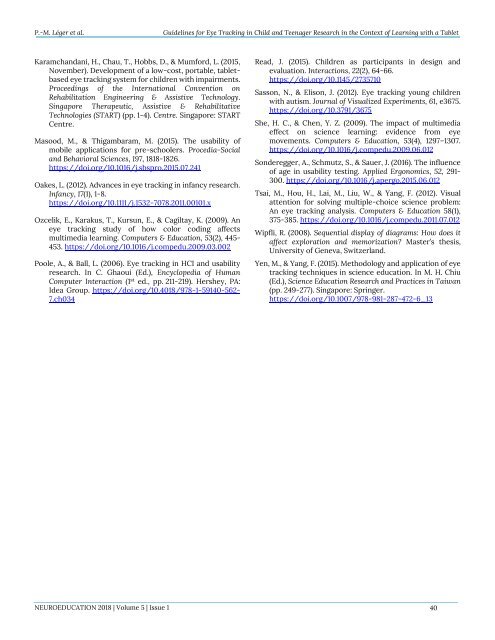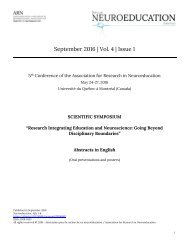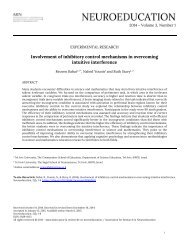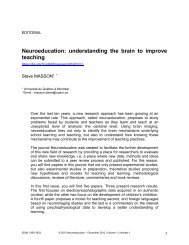Neuroeducation_2018_vol-5_no-1_full
Volume 5, Numéro 1 de la revue scientifique bilingue en libre accès Neuroéducation
Volume 5, Numéro 1 de la revue scientifique bilingue en libre accès Neuroéducation
- No tags were found...
Create successful ePaper yourself
Turn your PDF publications into a flip-book with our unique Google optimized e-Paper software.
P.-M. Léger et al.<br />
Guidelines for Eye Tracking in Child and Teenager Research in the Context of Learning with a Tablet<br />
Karamchandani, H., Chau, T., Hobbs, D., & Mumford, L. (2015,<br />
November). Development of a low-cost, portable, tabletbased<br />
eye tracking system for children with impairments.<br />
Proceedings of the International Convention on<br />
Rehabilitation Engineering & Assistive Tech<strong>no</strong>logy.<br />
Singapore Therapeutic, Assistive & Rehabilitative<br />
Tech<strong>no</strong>logies (START) (pp. 1-4). Centre. Singapore: START<br />
Centre.<br />
Masood, M., & Thigambaram, M. (2015). The usability of<br />
mobile applications for pre-schoolers. Procedia-Social<br />
and Behavioral Sciences, 197, 1818-1826.<br />
https://doi.org/10.1016/j.sbspro.2015.07.241<br />
Oakes, L. (2012). Advances in eye tracking in infancy research.<br />
Infancy, 17(1), 1-8.<br />
https://doi.org/10.1111/j.1532-7078.2011.00101.x<br />
Ozcelik, E., Karakus, T., Kursun, E., & Cagiltay, K. (2009). An<br />
eye tracking study of how color coding affects<br />
multimedia learning. Computers & Education, 53(2), 445-<br />
453. https://doi.org/10.1016/j.compedu.2009.03.002<br />
Poole, A., & Ball, L. (2006). Eye tracking in HCI and usability<br />
research. In C. Ghaoui (Ed.), Encyclopedia of Human<br />
Computer Interaction (1 st ed., pp. 211-219). Hershey, PA:<br />
Idea Group. https://doi.org/10.4018/978-1-59140-562-<br />
7.ch034<br />
Read, J. (2015). Children as participants in design and<br />
evaluation. Interactions, 22(2), 64-66.<br />
https://doi.org/10.1145/2735710<br />
Sasson, N., & Elison, J. (2012). Eye tracking young children<br />
with autism. Journal of Visualized Experiments, 61, e3675.<br />
https://doi.org/10.3791/3675<br />
She, H. C., & Chen, Y. Z. (2009). The impact of multimedia<br />
effect on science learning: evidence from eye<br />
movements. Computers & Education, 53(4), 1297–1307.<br />
https://doi.org/10.1016/j.compedu.2009.06.012<br />
Sonderegger, A., Schmutz, S., & Sauer, J. (2016). The influence<br />
of age in usability testing. Applied Ergo<strong>no</strong>mics, 52, 291-<br />
300. https://doi.org/10.1016/j.apergo.2015.06.012<br />
Tsai, M., Hou, H., Lai, M., Liu, W., & Yang, F. (2012). Visual<br />
attention for solving multiple-choice science problem:<br />
An eye tracking analysis. Computers & Education 58(1),<br />
375-385. https://doi.org/10.1016/j.compedu.2011.07.012<br />
Wipfli, R. (2008). Sequential display of diagrams: How does it<br />
affect exploration and memorization? Master’s thesis,<br />
University of Geneva, Switzerland.<br />
Yen, M., & Yang, F. (2015). Methodology and application of eye<br />
tracking techniques in science education. In M. H. Chiu<br />
(Ed.), Science Education Research and Practices in Taiwan<br />
(pp. 249-277). Singapore: Springer.<br />
https://doi.org/10.1007/978-981-287-472-6_13<br />
NEUROEDUCATION <strong>2018</strong> | Volume 5 | Issue 1 40








